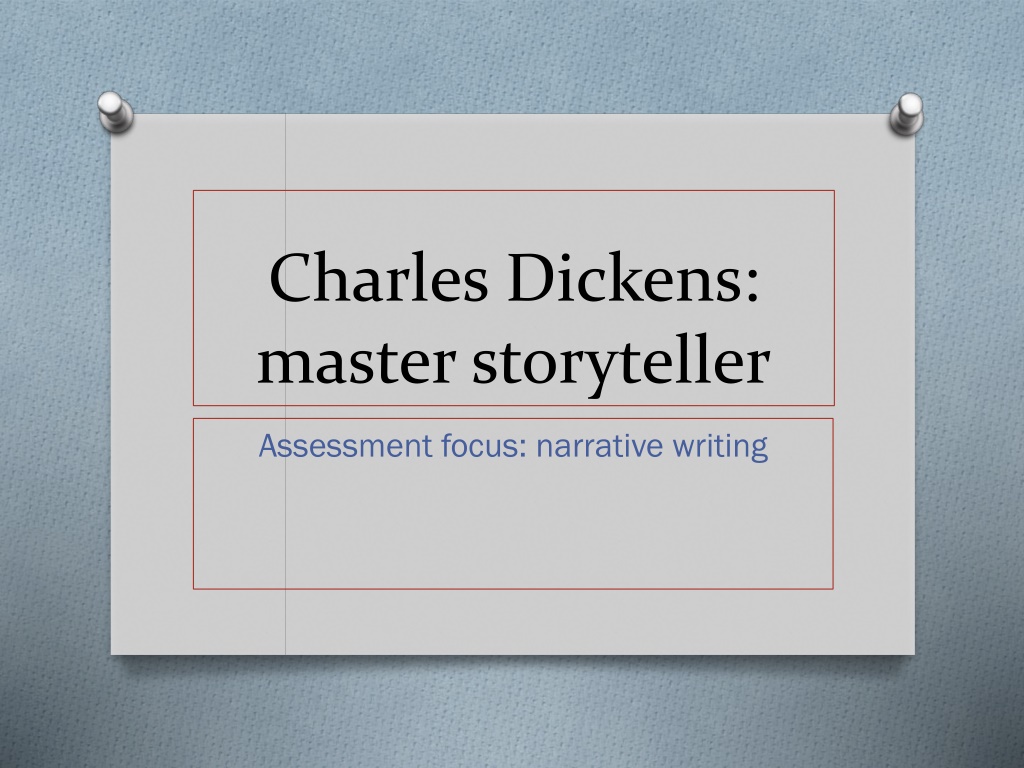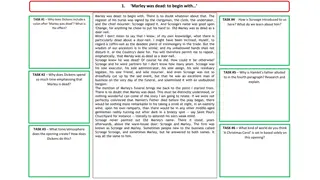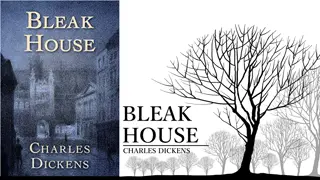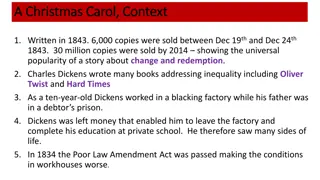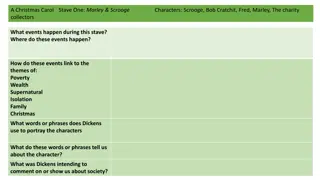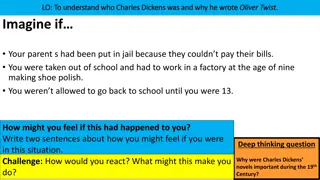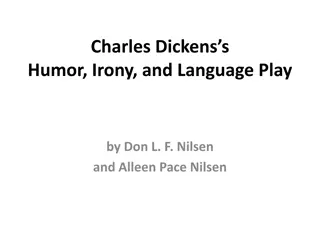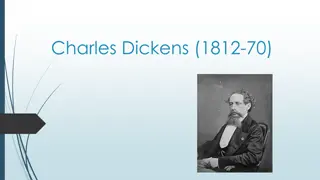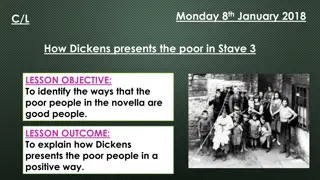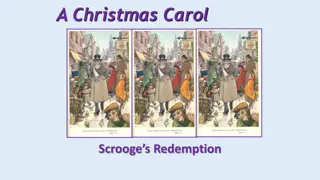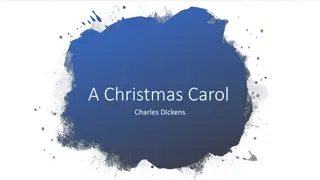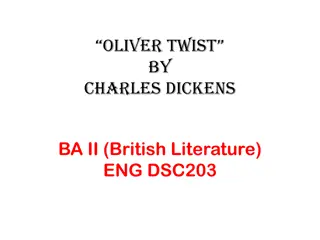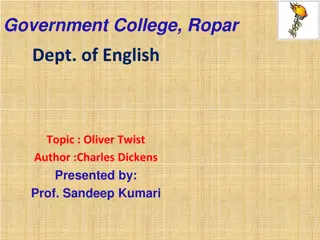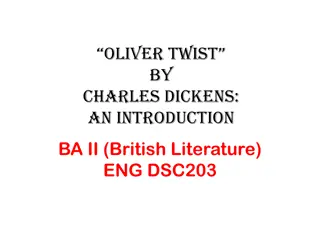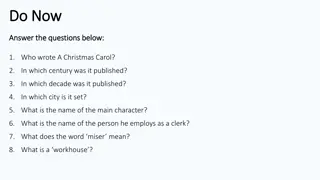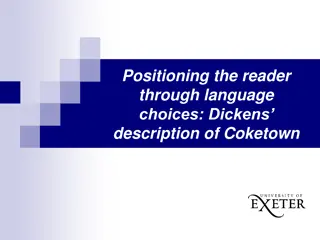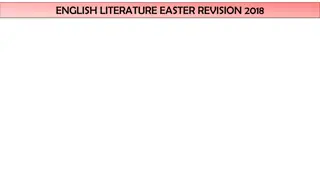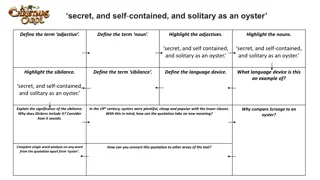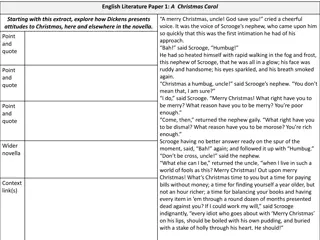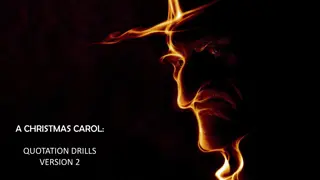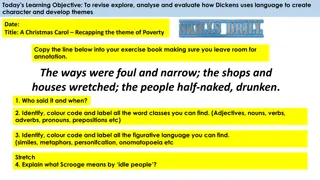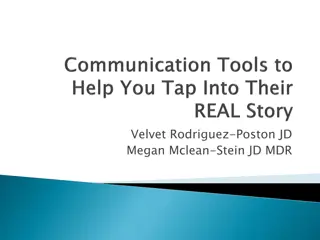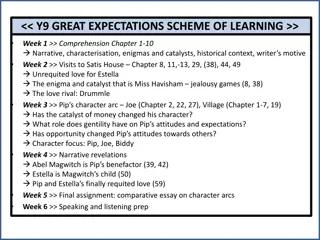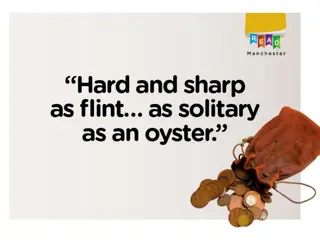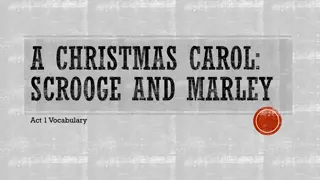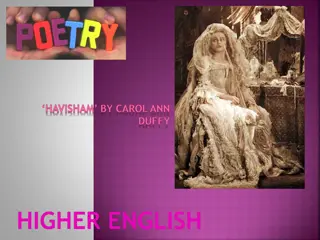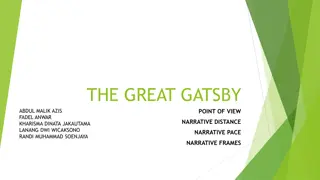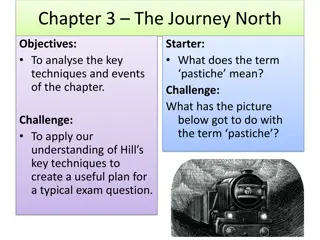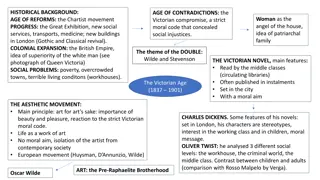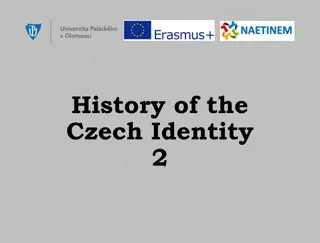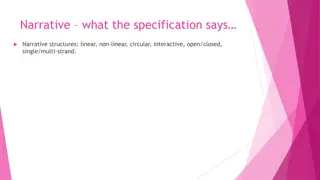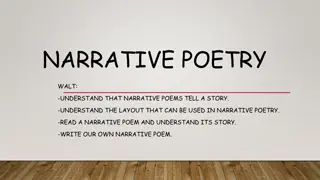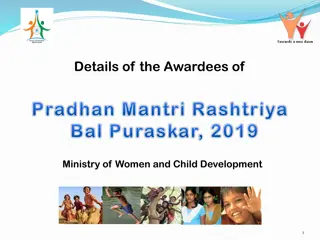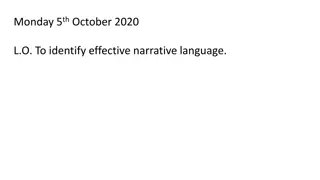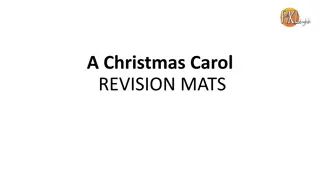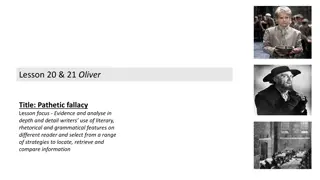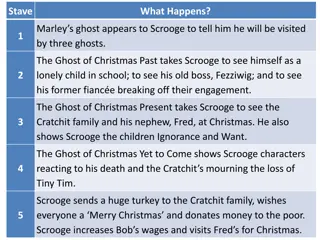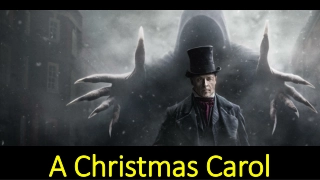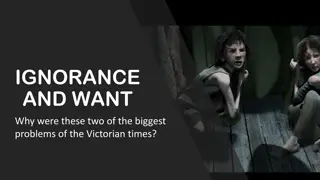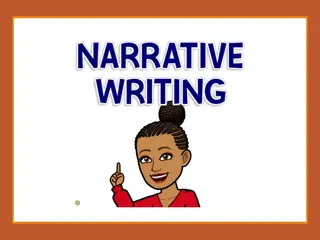Exploring Charles Dickens: Master Storyteller and Narrative Techniques
Delve into the world of Charles Dickens, a master storyteller known for his captivating narratives. Learn about the effectiveness of opening lines in storytelling, techniques to make writing interesting, and Dickens's appeal to the senses in his descriptions. Explore his childhood, family life, works, and his concerns about the poor and needy in Victorian London.
Download Presentation

Please find below an Image/Link to download the presentation.
The content on the website is provided AS IS for your information and personal use only. It may not be sold, licensed, or shared on other websites without obtaining consent from the author. Download presentation by click this link. If you encounter any issues during the download, it is possible that the publisher has removed the file from their server.
E N D
Presentation Transcript
Charles Dickens: master storyteller Assessment focus: narrative writing
Which is the most effective opening line? Why? All happy All happy families are alike; each are alike; each unhappy family is unhappy family is unhappy in its unhappy in its own way. own way. families Marley was dead, Marley was dead, to begin with. to begin with. There There is no doubt is no doubt whatever about whatever about that. that. As Gregor As Gregor Samsa awoke one awoke one morning from morning from uneasy dreams uneasy dreams he found himself he found himself transformed in transformed in his bed into a his bed into a monstrous monstrous vermin vermin Samsa It was the best of It was the best of times, times, it was the it was the worst of times, it worst of times, it was the age of was the age of wisdom, it was wisdom, it was the age of the age of foolishness foolishness It It was the day my was the day my grandmother grandmother exploded. exploded. All children, All children, except one, grow except one, grow up. up. The past is a The past is a foreign foreign country; country; they do things they do things differently there. differently there. It was a bright It was a bright cold day in cold day in April, and the clocks and the clocks were striking were striking thirteen. thirteen. April, What makes an enticing hook at the start of a story?
How do good writers make their writing interesting? Add to your list as we discuss your ideas
HW: Research Dickens O His childhood O His family O His work O Life in London in Victorian times O His concerns about the plight of the poor and needy
How does Dickens appeal to the senses in this description? Sight Sight Smell Sound Touch What other techniques does he use?
Write 5-6 sentences to appeal to the senses of your reader O Ideas if you re stuck: O A Saturday lunchtime in a crowded fast-food restaurant O A football match O A beach on August bank holiday weekend O A music festival Banned phrases: (All)I could see/taste/ hear/ feel Challenge: make sure you vary your sentence types/starters
Varying Sentences O Simple Sentences Simple Sentences a sentence that contains one a sentence that contains one clause: clause: My hands were shaking. My hands were shaking. O Compound Sentences Compound Sentences a sentence that joins two main clauses together using a connective: main clauses together using a connective: My hands were shaking and a bead of sweat ran My hands were shaking and a bead of sweat ran down my cheek. down my cheek. O Complex Sentences Complex Sentences a sentence that contains two a sentence that contains two clauses however the subordinate clause is reliant clauses however the subordinate clause is reliant on the main clause: on the main clause: Although my hands were shaking and sweat ran Although my hands were shaking and sweat ran down my cheek, I forced myself to continue down my cheek, I forced myself to continue a sentence that joins two
Varying Sentence Openings O Start with a verb ( Start with a verb ( - -ing ing ) ) Smashing against the bottom of the rocks, the waves Smashing against the bottom of the rocks, the waves sent white foam shooting into the air. sent white foam shooting into the air. O Start with as or while (prepositions Start with as or while (prepositions you can also use prepositions like under, behind, before etc ) use prepositions like under, behind, before etc ) As the skies darkened, raindrops began to pour down. As the skies darkened, raindrops began to pour down. While the gulls screamed overhead, a lonely dog raced While the gulls screamed overhead, a lonely dog raced along the wet sand. along the wet sand. O Start with an adjective Start with an adjective Grotesque images danced before my eyes. Grotesque images danced before my eyes. O Start with an adverb Start with an adverb Silently, he crept towards the exit Silently, he crept towards the exit you can also
Read Christmas at the Cratchits O How does Dickens create an atmosphere of warmth and goodwill in this extract from A Christmas Carol? O How could you change the following to create a gloomy and depressing atmosphere? There never was such a goose. Bob said he didn t believe there ever was such a goose cooked. Its tenderness and flavour, size and cheapness, were the themes of universal admiration. Eked out by apple- sauce and mashed potatoes, it was a sufficient dinner for the whole family; indeed, as Mrs Cratchit said with great delight (surveying one small atom of a bone upon the dish), they hadn t ate it all at last
How does Dickens evoke sympathy for Tiny Tim in the reader?
Dickens was concerned with promoting social reform O Read the extract from Nicholas Nickleby Wackford Squeers: headmaster of Dotheboys Hall O How is this moral viewpoint evident in the language he uses to describe the situation for the students at Dotheby s Hall? O How does Dickens use the characters of Wackford Squeers and Nicholas Nickleby to exemplify what he thought needed changing in society?
How does the writer portray the suffering of the pupils in this extract? But the pupils--the young noblemen! How the last faint traces of hope, the remotest glimmering of any good to be derived from his efforts in this den, faded from the mind of Nicholas as he looked in dismay around! Pale and haggard faces, lank and bony figures, children with the countenances of old men, deformities with irons upon their limbs, boys of stunted growth, and others whose long meagre legs would hardly bear their stooping bodies, all crowded on the view together; there were the bleared eye, the hare-lip, the crooked foot, and every ugliness or distortion that told of unnatural aversion conceived by parents for their offspring, or of young lives which, from the earliest dawn of infancy, had been one horrible endurance of cruelty and neglect. There were little faces which should have been handsome, darkened with the scowl of sullen suffering; there was childhood with the light of its eye quenched, its beauty gone, and its helplessness alone remaining; there were vicious-faced boys, brooding, with leaden eyes, like malefactors in a gaol; and there were young creatures on whom the sins of their frail parents had descended, weeping even for the mercenary nurses they had known, and lonesome even in their loneliness. With every kindly sympathy and affection blasted in its birth, with every young and healthy feeling flogged and starved down, with every revengeful passion that can fester in swollen hearts, eating its evil way to their core in silence, what an incipient Hell was breeding here!
Moral messages O What moral messages could you include in a story set in the Victorian era? O Would these messages differ from the messages Dickens might wish to convey to a modern audience? If so, why? If not, why not?
Broken-hearted vengeance: Miss Havisham Focus on the description of Miss Havisham on pp.62-3: O How does Dickens use language to create a positive impression of Miss Havisham? O How is that contrasted with the reality of her appearance? O Comment on the effects on the reader of this quotation: she sat, corpse-like the frillings and trimmings on her bridal dress looking like earthy paper (p.67)
Magpie interesting words or phrases from the extracts studied O Consider interesting words and phrases that you could incorporate into your own Dickensian style tale O Divide the words into those describing themes, character and setting
HW: Create your own Victorian character on paper Consider: Personality- good & bad points Appearance- adult or child Job/role Family/relationships What sophisticated & Dickensian vocabulary could you use to describe them? Include a picture
Write a paragraph describing your character What sophisticated vocabulary & language/literary techniques could you use to describe them?
Magpie interesting words or phrases from the extracts studied O Consider interesting words and phrases that you could incorporate into your own Dickensian style tale O Divide the words into those describing themes, character and setting
HW: Read the information about life in the workhouse O Answer the questions in the space provided (you will need to print them from the document on Insight)
The Poorhouse: Oliver Twist O How does Dickens account of Oliver Twist s experiences compare to the account you read? O Make a list of the ways Oliver s experiences differ from your childhood http://www.workhouses.org.uk/education/workhouseboys1909.jpg Using sophisticated vocabulary, write a Dickensian description of an aspect of your life that Using sophisticated vocabulary, write a Dickensian description of an aspect of your life that differs from Oliver Twist s childhood: e.g. home, schooling, employment, access to food differs from Oliver Twist s childhood: e.g. home, schooling, employment, access to food
Dickens' style of writing Dickens was once a newspaper reporter; his descriptions show a wonderful eye for detail detail. Great Expectations had to fill ten columns of All Year Round each week, for 36 weeks. Dickens' style of writing therefore 'filled space', and included lots of repetition lists lists. Dickens loved words, and liked to produce a 'pretty piece of writing' in different styles. He included lots of powerful adjectives, and is famous for his use of metaphors and similes. His descriptions often present people, their surroundings, and even the weather, in ways which reinforce each other, so that a certain 'feel' is built up through the passage. From the early 1850s, Dickens gave public readings of his novels. His writing is rhythmic and designed to be read out loud. He loved to make young women in his audience laugh or weep, so many of his characters are either hilariously comic sentimental. Dickens was a master of dialect and used what is called 'substandard' speech to add to the picture of a character he was building up. In 1857, Dickens wrote and acted in a play called The Frozen Deep. Critics believe this helped him to write the brilliant sections of dialogue in Great Expectations. Dickens is famous for his exaggeration exaggeration, which critics have linked to his love of the stage. O O repetition and long O rhythmic O comic or heart-breakingly O O
Writers techniques: How does Dickens use sentence structure to create an effect? Identify examples of emotive language which conveys the boys hunger. The room in which the boys were fed was a large stone hall, with a copper at one end: out of which the master, dressed in an apron for the purpose, and assisted by one or two women, ladled the gruel at meal-times. Of this festive composition each boy had one porringer, and no more- except on occasions of great public rejoicing, when he had two ounces and a quarter of bread besides. The bowls never wanted washing. The boys polished them with their spoons till they shone again; and when they had performed this operation (which never took very long, the spoons being nearly as large as the bowls), they would sit staring at the copper, with such eager eyes, as if they could have devoured the very bricks of which it was composed; employing themselves, meanwhile, in sucking their fingers most assiduously, with the view of catching up any stray splashes of gruel that might have been cast thereon. Boys have generally excellent appetites. Oliver Twist and his companions suffered the tortures of slow starvation for three months: at last they got so voracious and wild with hunger, that one boy, who was tall for his age, and hadn't been used to that sort of thing (for his father had kept a small cookshop), hinted darkly to his companions, that unless he had another basin of gruel per diem, he was afraid he might some night happen to eat the boy who slept next him, who happened to be a weakly youth of tender age. He had a wild, hungry eye; and they implicitly believed him.
Magpie interesting words or phrases from the extracts studied O Consider interesting words and phrases that you could incorporate into your own Dickensian style tale O Divide the words into those describing themes, character and setting
The Black Veil A Short Story
Plot Structure Basics Plot is the arrangement of events in a literary work.! There are six main components to plot, and you can understand them better if you think of them in a figure like this: Climax Climax Rising Action Rising Action Falling Action Falling Action Resolution Resolution Exposition Exposition Conflict Conflict is the problem at the root of the story. Map the plot of The Black Veil onto this structure Map the plot of The Black Veil onto this structure.
Elements of Plot O Exposition The situation is explained and characters introduced. O Rising Action Events moving toward a high point of action. O Conflict A struggle develops between two opposing forces. O Climax Events reach a turning point. O Falling Action events following the climax that lead to the ending. O Resolution The outcome of the conflict is settled. From Prentice Hall s Timeless Voices, Timeless Themes Bronze Level p. 665
Technique focus: pathetic fallacy and foreshadowing O Read the opening to A Black Veil O How does Dickens use language to create tension and suspense? O Identify 3 quotations that add to the mysterious and sinister atmosphere; explode them
Detailed analysis Who Says it? Who Says it? Character? Narrator? What is happening at the What is happening at the time? time? Does this quotation link Does this quotation link one character/event to one character/event to another? another? What does it show about What does it show about the character? the character? Exploding Quotations! What does it mean What does it mean metaphorically? metaphorically? What does it tell you What does it tell you about events in the about events in the story? story? How does it fit in with How does it fit in with other themes or ideas in other themes or ideas in the story? the story? What is the effect on the What is the effect on the reader? reader? How does it work? How does it work? Is it a comparison? Is it a comparison? Does it give a strong Does it give a strong picture? picture? What technique does the What technique does the writer use? writer use?
Structure: punctuation and paragraphing O How does the use of dashes and exclamation marks in the story show the emotions of the characters? O Comment on the effect of the variety of paragraph lengths at moments of tension within the story O How effective are the first and last lines of the story? Justify your response with close reference to the text
Case Study: punctuation for effect. Effect of the exclamation mark after a minor sentence? Effect of exclamation mark? Oh! but he was a tight- fisted hand at the grindstone, Scrooge! a squeezing, wrenching, grasping, scraping, clutching, covetous old sinner! Hard and sharp as flint, from which no steel had ever struck out generous fire; secret, and self-contained, and solitary as an oyster. Effect of a long list punctuated by commas? Effect of the semi-colon? Extract from A Christmas Carol by Charles Dickens
Comment on the effects of the punctuation in this passage. What is the effect of the exclamation marks? Where do they come in the sentence? Why? How do they affect the tone tone of the text? True! nervous very, very dreadfully nervous I had been and am! but why will you say that I am mad? The disease had sharpened my senses not destroyed not dulled them. What is the effect of the dashes? Think about how smoothly the passage reads. How would it affect the text if they were not there? Extract from Tell-Tale Heart by Edgar Allen Poe
Magpie interesting words or phrases from the short story O Consider interesting words and phrases that you could incorporate into your own Dickensian style tale O Divide the words into those describing themes, character and setting
PRACTICING HOW TO WRITE VIVIDLY technique example Ellipsis/dashes/ exclamation marks for effect Appeal to the senses Short sentence for impact. Sense of being foreboding Metaphor/ Simile Personification Mood/atmosphere Show-not-tell Pathetic fallacy Emotive language
Assessment Narrative Writing: Write the opening to a novel or a short story inspired by Charles Dickens
Planning your own story Setting Setting Plot Plot (Structure) (Structure) Characters Characters Genre Genre Mood/ Mood/ atmosphere atmosphere Themes/ Themes/ message message Techniques Techniques What magpied vocabulary could you use to create a Dickensian feel to your story? How will you open and close your narrative?
